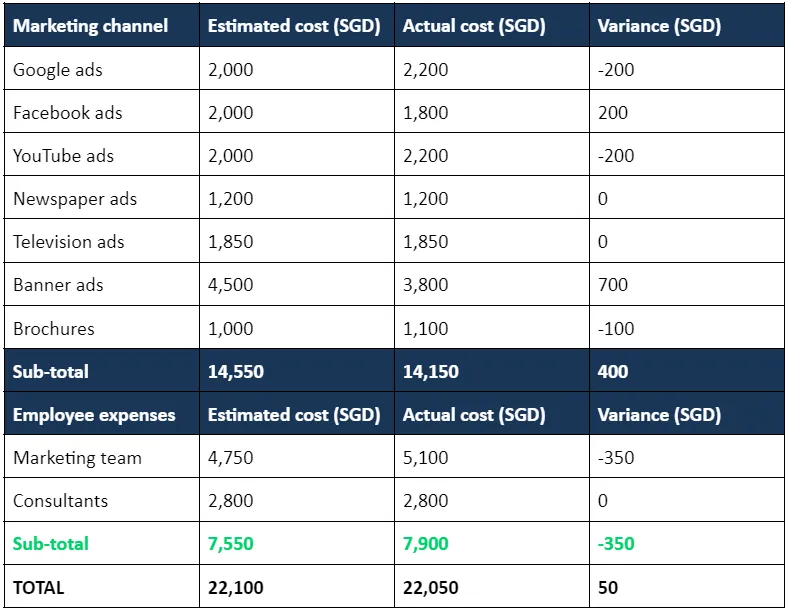Summary
You’ve developed a strong marketing campaign that you are confident will make your brand a household name. That’s terrific news, but a great plan needs a great budget. A well-devised marketing budget will give your campaign direction, help you make the most of your money, and ensure that you hit your targets. Marketing is crucial to growing your business, and an effective marketing budget takes you that much closer to your goals. This is especially true for small businesses, which need to keep expenses low as they scale up operations.
If you’re unsure about what a good marketing budget plan looks like or have never created one, you’ve come to the right place. In this article, we’ll walk you through the basic steps of creating a great marketing budget for your company. But before that, what is a marketing budget, and why do you need one?

What is a marketing budget?
A marketing budget is a plan outlining the amount of money a business allocates to marketing projects and how it plans to spend that money over a given period. It should be comprehensive, covering all the major aspects of your business such as conducting market research, planning and developing a product, advertising and promoting that product, and so on. Marketing budgets can vary depending on the type of projects they are related to. For instance, if you plan to launch a new product, you’ll need a product marketing budget. But if your marketing campaign is built around creating and promoting content, you’ll need a content marketing budget. Other types of marketing budgets include advertising, public relations, event, website redesign, and branding budgets. Then there is the master budget, which brings together all these individual marketing budgets to give a comprehensive overview of a company’s total marketing spend.
Take a look at any marketing budget example and you’ll see a lot of line items or channels. Here are some typical marketing channels:
- Social media – Facebook, Twitter, Instagram, YouTube, etc
- Offline channels – Billboards, television and radio advertisements, print advertisements, flyers, etc
- Paid search – Pay-per-click (PPC) advertisements on Google that appear in the form of links to websites or visual product listings, for example
- Mobile marketing – SMS marketing, social media marketing, location-based marketing, etc
- Event marketing – Community events, lunch-and-learns, marathons, auctions, etc
- Email marketing – Product updates, invitations to events, promotional campaigns, etc
- Search engine optimisation (SEO)
A marketing budget can be quarterly or annual. Many businesses tend to create an annual marketing budget based on expenses in the previous year. They then make adjustments to the budget when the need arises. This is definitely convenient. But it is more beneficial to revisit your marketing budget every quarter because marketing spend and efforts might vary significantly from quarter to quarter. For example, advertising spend usually peaks at the introduction and growth stages of a product but goes down thereafter. This will reflect on your marketing budgets. Similarly, a marketing budget built around a one-time event, such as a trade fair, will be different from both its preceding and succeeding budgets.
Marketing budgets are critical to staying competitive. This fact is not lost on businesses across the world. It’s the reason why the share of marketing budgets as a percentage of company revenue has gone up to 9.5% in 2022, up from 6.4% a year ago, according to Gartner’s Annual CMO Spend Survey.
Why do you need a marketing budget?
A marketing budget plan does more than keep expenses in check. Here are some of its benefits:
- A marketing budget helps businesses allocate resources efficiently so that projects and campaigns don’t suffer from a lack of funds, equipment, infrastructure, and personnel.
- A marketing budget sharpens the focus of marketing efforts as it takes into consideration exactly what a company wants from a campaign and how much they are willing to spend on it.
- By knowing how much money they have, businesses can prioritise campaigns and pick marketing channels that give them the highest return on investment (ROI).
- A marketing budget helps companies set specific, realistic, measurable, and timely targets that are aligned with organisational goals and strategies. Furthermore, marketing budgets also provide a basis to measure and assess those goals and targets in the form of key performance indicators (KPIs). Marketing KPIs tell you whether you are on track to meet your set targets.
- By setting specific and measurable goals, marketing budgets allow staff to focus on tasks and activities without distractions.
- A marketing budget also enables seamless coordination between departments such as finance, marketing, operations, and human resources.
- Creating a marketing budget is the best way to avoid hidden costs. For example, if you’ve budgeted only for product promotion but left out market research, you’ll end up forking out money you didn’t plan to spend. The research cost becomes an unforeseen expense. A marketing budget will ensure you have a detailed marketing plan where each channel is accounted for.
What is marketing cost?
When we speak about marketing budgets, we cannot leave out marketing costs. Marketing costs are expenses related directly to designing, developing, selling, and promoting your goods. The cost of a TV or Google ad or the marketing team’s salaries are examples of marketing cost. Here is a more detailed list:
1. Advertising cost
This includes expenses incurred on print (newspapers and magazines), video (television and YouTube), audio (radio and podcast), and social media (Twitter, Instagram, Facebook, etc) ads as well as billboards, hoardings, and flyers, to name a few. Social media marketing is popular in Singapore, where both the social media and internet penetration rates are around 88%.
2. Content creation cost
This includes costs associated with the creation and distribution of blog posts, videos, photos, e-books, playbooks, how-to guides, checklists, webinars, social media posts, hashtags, templates, and downloads, to name a few. According to one study, engaging and high-quality content generates three times the leads (potential customers) and costs 62% less than traditional offline marketing. The survey adds that global internet users spend 20% of their online time going through various types of content.

3. Research cost
Expenses incurred on conducting market research through mail and phone surveys, focus group interviews, questionnaires, field trials, and various other methods come under research cost. Market research is generally considered expensive, which might deter many small businesses. However, systematic and structured research is known to drive growth and profit. It is possible to conduct market research while keeping costs low. Businesses can opt for less expensive options – phone interviews instead of face-to-face interviews – and keep the sample size small.
4. IT infrastructure cost
From creating promotional campaigns and designing content to automating and analysing data and collaborating with different teams, there is software for almost every marketing function. Software expenses are an essential item in any marketing budget. However, marketing budgets cover numerous other IT infrastructure costs – for equipment (computers, phones, tablets, etc) and services (internet, analytics, etc) as well as payments for staff and specialists.
5. Personnel costs
Many companies recruit freelancers for their marketing initiatives while others hire full-time employees. Their wages must be included in the marketing budget. For employees, expenses incurred on equipment, technology, training, benefits, and travel must also be factored in.
6. Agency fees
Hiring external marketing agencies and consultants is common practice. For example, 62% of businesses worldwide reportedly outsource their content marketing. Small businesses might prefer to outsource than to have an in-house team so as to save on hiring, onboarding, and training costs. For businesses that use external agencies and consultants, the associated costs would be included in their marketing budget.
7. Sponsorships
When your business funds an event (say, a children’s football match) or organisation (non-profit, charity, etc) in a mutually beneficial deal, it is called sponsorship marketing. Sponsorship marketing is a great way to increase brand awareness, improve your business’ reputation, and meet potential customers while keeping your marketing costs low. It is, therefore, an attractive marketing option for small businesses. A typical sponsorship-related marketing expense is the cost of designing football jerseys bearing your company’s brand and logo or a financial contribution to a local charity.
Who is involved in marketing budget planning?
Budget planning is a collective effort. Developing a marketing budget is not the sole responsibility of the marketing team. Here are the roles the following departments play in budget formation:
1. Marketing department
The main responsibility, naturally, lies with the marketing team. The marketing manager or chief marketing officer (CMO) proposes the marketing budget based on past budgets, the requests and recommendations of various programme heads (the social media, digital marketing, and content managers, for example), and the competition’s budget outlay. The CMO has a pulse on all aspects of marketing, from planning strategy and managing talent to innovating and growing revenue. With this expertise, they can create a strong and effective marketing budget.
2. Finance department
The marketing team then holds consultations with the finance department. Together, they decide marketing budget allocations. For example, how much can the company invest in a campaign? Other budgeting decisions – such as hiring an in-house expert versus working with a freelancer – are also taken. The finance department’s in-depth knowledge of the company’s finances can help the marketing team cut costs where there is room to save. After the budget has been reviewed and approved by the finance team, it is sent to the business leadership for final approval.
3. Business leadership
The leadership has the final say in the matter. Based on their interventions and suggestions, the marketing budget might have to undergo several tweaks and adjustments before it is finalised.
How to create a marketing budget?
Here’s how you can create an effective marketing budget in six steps:
1. Identify your marketing goals
The first step to creating a marketing budget is to set marketing goals. Marketing goals can be both short-term or long-term. Improving traffic to your website by 10% or attracting 100 new followers on your Facebook page are examples of short-term goals. An SEO campaign targeted at getting your product on the front page of Google within the year could be a long-term goal. Remember to align these goals with your organisation’s overall mission. Also, while goal-setting is important, it is also necessary to revisit these marketing goals periodically to ascertain that they are being met. This is why setting KPIs as a goal assessment tool is vital to budget planning.
2. Know your buyers
Understanding your target audience is critical to marketing success. After all, your product might not be for everyone. It’s good to be as specific as possible. How old are your customers? What kind of jobs do they hold? Are they married or single? Where do they live? What are their educational backgrounds, average income, and so on? What kind of media do they consume? Surveys, interviews, and social media insights provide the answers to most of these questions. To complete your buyer’s profile, you’ll also need to look into their buyer’s journey, or the steps they take from prospective customer to actual buyer. You’ll need to monitor where they came across your products (for example, on your website or social media pages), how often they visit these channels in a month, and the conditions that finally lead to them buying the product. In Singapore, search engines are a popular choice among prospective customers looking to discover new brands. Marketing automation software makes it easy to harvest this type of data.
3. Know your market and the competition
Just as you need to know your buyers, it’s equally important to understand your target market and your competitors. Apart from knowing where your potential customers live, what they do for a living, and how much they earn, keep an eye out for external factors that could affect their buying power – such as the state of the economy, or technological trends and advances that might have altered the way they shop or make payments. An important part of market research is to scope out the competition, specifically the marketing strategies they deploy, what’s working well for them, and how much they are spending. Studying your competitors and their experiences will point you to where you should be directing your efforts.
4. Choose your marketing channels
Based on insights from your buyer’s journey, you need to pick the right marketing channels to promote your products. Digital marketing makes up 56% of marketing budgets, says Gartner. Among digital channels, social media tops the list, followed by paid search. In Singapore, the most popular social media platforms are YouTube, WhatsApp, and Facebook.

A strong social media marketing plan is usually effective. If your target audience comprises Gen Zers, it makes sense to catch them on Instagram and YouTube. But if you are targeting older professionals, then LinkedIn is a better bet. Apart from factoring in your target audience, your choice of marketing channels should also be based on your products and goals. For example, if your goal is to form a deeper connection with existing customers, interacting with them on social media is the way to go. But if you wish to increase your brand presence and garner attention to your products, a billboard might do the trick more effectively. This is why many companies are now using a mix of traditional and digital marketing.
5. Make your marketing budget allocation
The calculations come next. How much do you allot to each channel and to your budget on the whole? Marketing budget allocation should be based on operational cost. Ask yourself how much it will cost in time and labour to hit your stated goal. Can you take care of it in-house or will you need to hire an external agency? Understanding operational cost is important for correct allocation. This formula can be replicated for each marketing channel. While setting your budget, it’s important to treat marketing as an investment and not an expense. This means setting aside a portion of your total revenue as marketing spend rather than using what’s left over after taking care of other expenses. In fact, small businesses may want to set aside a healthy chunk of their revenue for marketing if they have plans to grow. On the flipside, established businesses can probably afford to allocate a smaller percentage of their revenue for marketing efforts.
6. Monitor return on investment
Now that you have a budget and have implemented it, you’ll need to track its progress. The best way to do this is to set projected returns on investment (ROIs) for each marketing channel and goal. After launching your campaign, you can compare the actual ROI against the projected ROI and make adjustments as and when required. If your ROI on a given marketing channel is high, you might be inclined to spend more on that channel in your next budget. But if your ROI isn’t encouraging, you might want to scrap that channel altogether or see where you can make improvements.
Marketing budget example
Here’s an example of a simple advertising budget using traditional offline and digital marketing channels:

Note: Allocated amounts are examples and don’t necessarily reflect actual costs.
Save on marketing costs with Aspire
Hidden costs, unforeseen expenses, and overspending can derail a marketing budget. This can be a hard knock for small businesses with limited resources. But with Aspire Budgets and Spend Management, you don’t have to worry about going over budget:
- These features allow you to set spend limits, which you can cancel, freeze or update at any time.
- You’ll receive a notification each time you are nearing your budget.
- They make budget planning easier by allowing you to deploy budgets across teams and designate budget owners, all while retaining complete visibility.
- They come with corporate cards, which you can recharge with interest-free credit.
- What’s more, they can be easily incorporated with your accounting software, making for seamless budgeting.
If you’d like to know how a Singapore company saved on marketing costs with Aspire, click here.

.png)








%201.webp)


.webp)